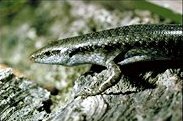Eutropis dawsoni, also known commonly as Gans's grass skink and Gans's mabuya, is a species of lizard in the family Scincidae. The species is endemic to the southern Western Ghats, India.

Brauer's burrowing skink, also known commonly as Brauer's skink, is a species of lizard in the family Scincidae. The species is endemic to the Seychelles.

The fire skink, also known commonly as Fernand's skink, the Togo fire skink, and the true fire skink, is a fairly large skink, a species of lizard in the family Scincidae. The species is known for its bright and vivid coloration. Native to tropical forests in West and Central Africa, the fire skink lives fifteen to twenty years. This species is a diurnal lizard that burrows and hides. It is relatively shy and reclusive, but may become tame in captivity.
Calamorhabdium is a small genus of snakes, commonly known as iridescent snakes, in the family Colubridae. The genus contains two described species. Both species are burrowing snakes found in Asia.

Lipinia pulchella, known commonly as the yellow-striped slender tree skink or beautiful lipinia, is a species of skink, a lizard in the family Scincidae. The species is endemic to the Philippines.

Chioninia vaillantii, also known commonly as Vaillant's mabuya or Vaillant's skink, is a species of skink in the family Scincidae. The species is endemic to the Cape Verde Islands. There are two recognized subspecies.

The Turkish worm lizard is a species of amphisbaenian in the family Blanidae. The species is native to Southeast Europe and the Middle East. There are two recognized subspecies.

Darevskia derjugini is a species of lizard in the family Lacertidae. The species is native to Southeast Europe and Western Asia. There are six recognized subspecies.
Emoia baudini, also known commonly as Baudin's emo skink, Baudin's skink, and the Great Bight cool-skink, is a species of lizard in the family Scincidae. The species is native to New Guinea, Maluku, and Sulawesi.
Battersby's emo skink is a species of lizard in the family Scincidae. The species is native to Oceania and Southeast Asia.

Emoia boettgeri, also known commonly as Boettger's emo skink, the Micronesia forest skink, and the Micronesia spotted skink, is a species of lizard in the family Scincidae. The species is native to Micronesia. There are no recognized subspecies.
Bogert's emo skink is a species of lizard in the family Scincidae. The species is native to Indonesia.
Emoia brongersmai, also known commonly as Brongersma's emo skink and Brongersma's forest skink, is a species of lizard in the family Scincidae. The species is native to Indonesia.
The teal emo skink is a species of lizard in the family Scincidae. The species is found throughout Oceania.
Emoia klossi, also known commonly as Kloss's emo skink, Kloss' emo skink, and Kloss' skink, is a species of lizard in the subfamily Eugongylinae of the family Scincidae. The species is native to Indonesia and Papua New Guinea.

Emoia slevini, also known commonly as the Mariana skink, Slevin's brown skink, Slevin's emo skink, and Slevin's skink, is a species of lizard in the family Scincidae. The species is endemic to the Mariana Islands.
Lygosoma bampfyldei, commonly known as Bampfylde's supple skink or Bampfylde's writhing skink, is a species of lizard in the subfamily Lygosominae of the family Scincidae. The species is endemic to Malaysia.
Papuascincus buergersi is a species of skink, a lizard in the family Scincidae. The species is endemic to Papua New Guinea.

Jagor's sphenomorphus is a species of skink, a lizard in the family Scincidae. The species is endemic to the Philippines. There are two recognized subspecies.

Scincella cherriei, commonly known as the brown forest skink and Cope's brown forest skink, is a species of lizard in the family Scincidae. The species is native to Central America and adjacent southeastern Mexico. Three subspecies are recognized.










